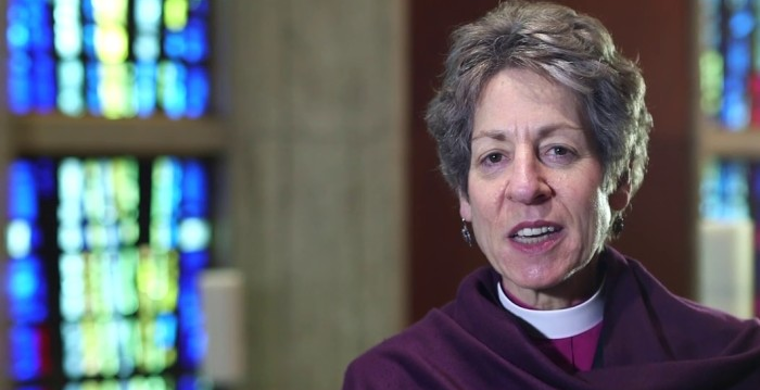Episcopalians Continue Bleeding Members, Attendance at Alarming Rate
By Jeff Walton
https://juicyecumenism.com/
October 9, 2015
Episcopal Church Presiding Bishop Katharine Jefferts Schori is leaving office this month after a tumultuous nine years in office that saw significant conflict and numerical decline in the oldline church.
Statistics released this week by the denomination's Office of Diocesan and Congregational Ministries indicate that Jefferts Schori is leaving her successor, Presiding Bishop-elect Michael Curry, with decline that is steepening rather than tapering off.
The church's domestic U.S. membership dropped 2.7 percent from a reported 1,866,758 members in 2013 to 1,817,004 in 2014, a loss of 49,794 persons. Attendance took an even steeper hit, with the average number of Sunday worshipers dropping from 623,691 in 2013 to 600,411 in 2014, a decline of 23,280 persons in the pews, down 3.7 percent.
The numbers are significantly worse than 2013, when the church reported a 1.4 percent decline in membership and 2.6 percent decline in average Sunday attendance. One contributing factor is figures from the Episcopal Church in South Carolina (TECSC), the local Episcopal Church jurisdiction formed after the Episcopal Diocese of South Carolina departed the denomination in the autumn of 2012. Updated figures from TECSC show that the body has 6,387 active baptized members and an average Sunday attendance of 2,812 persons. This is down 77 percent from the 28,195 members and 12,005 attendance average previously reported. The Diocese of South Carolina is one of five dioceses to depart the denomination since Jefferts Schori's election, along with hundreds of individual congregations. The Diocese of South Carolina has accepted an offer of oversight from the worldwide Anglican Communion's Global South and now functions independently from the U.S.-based Episcopal Church.
Other measures of Episcopal Church vitality also saw decline: the denomination reported the shuttering of 69 parishes and missions, down from 6,622 in 2013 to 6,553 in 2014. Children's baptisms declined 4.8 percent from 25,822 to 24,594 and adult baptisms declined during the same time-frame from 3,675 to 3,530, a decline of nearly 4 percent.
The number of marriages performed was a rare bright spot, rising from 9,933 in 2013 to 10,337 couples tying the knot in Episcopal Church ceremonies in 2014. The church does not report opposite-sex and same-sex marriages separately in its annual table of statistics. Burials also nudged up slightly, from 28,960 in 2013 to 29,011 in 2014.
While the Episcopal Church has established a continued pattern of steady decline since the early 2000s, the unbroken trend is relatively recent: the church lost only 18,000 members in the 1990s, a plateau that dropped off about the time Gene Robinson of New Hampshire was consecrated the church's first openly partnered gay bishop. Overall, the church has declined from a high of 3.6 million members in the mid-1960s to 1.8 million today, even as the U.S. population has more than doubled. The church has lost more than a quarter of its attendance since 2003.
In her opening sermon at the Episcopal Church's triennial General Convention meeting this summer in Salt Lake City, Utah, outgoing Presiding Bishop Katharine Jefferts Schori equated the denomination's condition to Jesus' healing of the bleeding woman and Jairus's daughter in Mark chapter 5:
"We have lived for too long like that shamed and bleeding woman. She's had to endure finger-waggers blaming her for her own illness. Anger and anxiety over membership loss in this church has frequently prompted finger-waggers to use that image of unstoppable hemorrhage -- and it's been going on for almost exactly 12 years, since we began to tell the truth about who we were and are and are meant to be. We have consulted plenty of ecclesiastical doctors, without much relief -- until we began to find the temerity to reach out and touch Jesus' robe. It's the same Temple-filling hem we heard about on Friday. The bleeding began to be staunched when we found the courage to reach out and touch the face of God, to see God at work in new contexts, and to have the confidence to claim our experience of the divine presence."
At the conclusion of her sermon, Jefferts Schori advised gathered church officials to "Pay no attention to the finger-wagging":
"Turn around and look for the hem of Jesus' robe. Go searching in new territory. Reach out and touch what is clothing the image of God. Give your heart to that search and you will not only find healing but become healing. Share what you find and you will discover the abundant life for which all God's children have been created. And indeed, the Lord will turn weeping into dancing. Talitha, cum. Get up, girl -- and boy, and woman and man -- get up and dance!"
END














